#outofplacebkm
Photo

Maria Martinez was among the best-known Pueblo potters of the 20th century. She pioneered the black-on-black style seen on this olla (water jar) in the 1910s without using a potter's wheel or glaze. Martinez built her vessels using hand-coiling techniques she had learned watching other Pueblo potters; then, natural materials, extensive polishing, and a specific firing process were used to create the matte designs and glossy surface. The designs combine Ancestral Pueblo practices with that of modern Pueblo, even incorporating certain elements of the Art Deco movement popular at the time through shape and geometric form. Based at the foot of the Black Mesa in Po-Woh-Geh-Owingeh (San Idelfonso Pueblo), Martinez created pottery as works of art, often to be sold to non-Native people traveling through New Mexico. Her work continues to inspire artists today, including Jeffrey Gibson, who has referenced her black-on-black style in his own ceramics.
See this olla on view in Out of Place: A Feminist Look at the Collection through January 3.
Posted by Forrest Pelsue
Maria Martinez (Po-who-ge-oweenge (San Ildefonso Pueblo), New Mexico, 1887–1980). Olla (Water Jar), circa 1923. Ceramic. Brooklyn Museum; Gift of Graham and Megan Marks in memory of Barbara and Fred Marks, 2013.100.4.
#outofplacebkm#Maria Martinez#brooklyn museum#Pueblo#potters#olla#water jar#new mexico#ancestral#art deco#shape#geometric#black mesa#Po-Woh-Geh-Owingeh#San Idelfonso Pueblo#Jeffrey Gibson#ceramics
314 notes
·
View notes
Video
🎶🎙💃🏿🎨#ArtIsAWeapon In celebration of #WomensHistoryMonth, today @brooklynmuseum #FirstSaturdaysBKM presents "Geographies of Gender" featuring #art #music #danceperformance and more. 5PM-11PM. Full schedule: www.brooklynmuseum.org • • Reposted from @brooklynmuseum Join women and nonbinary artists at this weekend’s #firstsaturdaysbkm in celebration of #WomensHistoryMonth. The evening kicks off with a curator tour of #outofplacebkm, followed by appearances by @sammusmusic @naimagreen @sabineblaizin @bgburlesque @thelma_lalal @ushamamii @belladonnaseries @hanae_utamura @christopher_unpezverde_nunez and more. Tap link in bio for the full lineup! • • #WomenArtists #BrooklynMuseum #TraScapades #ArtIsAWeapon #BlackGirlArtGeeks🤓 https://www.instagram.com/p/B9bv-2YAuLx/?igshid=6f2f03mx0y8a
#artisaweapon#womenshistorymonth#firstsaturdaysbkm#art#music#danceperformance#outofplacebkm#womenartists#brooklynmuseum#trascapades#blackgirlartgeeks🤓
0 notes
Photo
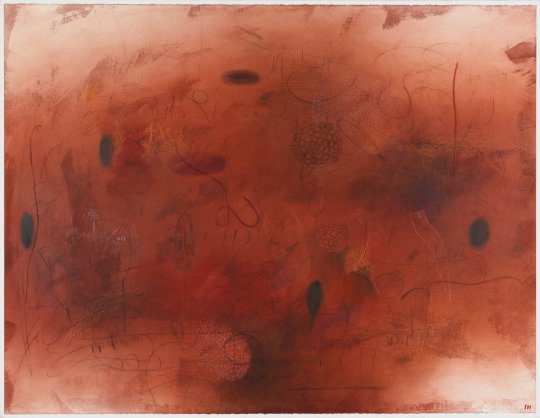
Emmi Whitehorse makes her artwork in the round, laying paper on a flat surface and moving around it as she works. Born and raised on a Navajo reservation, Whitehorse attributes this approach to the cultural traditions of her community, such the way houses are built to be round rather than square. She finds inspiration in the Southwestern landscape and in traditional wool-dyeing and weaving techniques. Whitehorse says, "My paintings tell the story of knowing land over time—of being completely, microcosmically within a place. I am defining a particular space, describing a particular place. They are purposefully meditative and meant to be seen slowly. The intricate language of symbols refer to specific plants, people and experiences."
See Fire Weed on view in Out of Place: A Feminist Look at the Collection through January 3.
Author: Forrest Pelsue
Emmi Whitehorse (Navajo, born 1957). Fire Weed, 1998. Chalk, graphite, pastel and oil on paper mounted on canvas. Brooklyn Museum, Gift of Hinrich Peiper and Dorothee Peiper-Riegraf in honor of Emmi Whitehorse, 2006.49. © artist or artist's estate
#outofplacebkm#emmi whitehorse#native american heritage month#indigenous#art#artist#artwork#chalk#drawing#oil#culture#navajo#community#houses#southwestern#landscape#story#land#time
265 notes
·
View notes
Photo
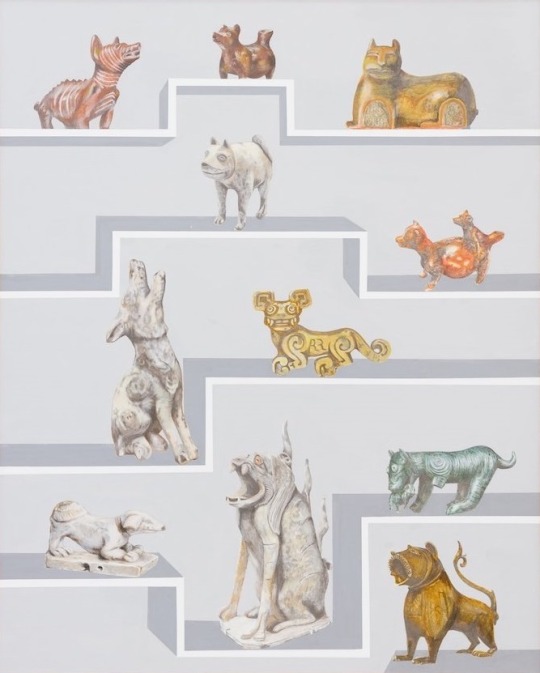
Interested in how museums construct art-historical narratives, Gala Porras-Kim incorporates objects from museum collections into drawings that are at once humorous and critical. 13 International Dogs may appear deadpan in its seemingly clinical representation of variously animated ancient canines from global art history, but Porras-Kim looks insightfully at the ways the meanings of objects change when they enter different spaces and different histories, especially through the conceptual work of an artist. Have museums artificially separated historical objects from contemporary art? What happens to the meaning of both when they become part of an integrated conversation?
See 13 International Dogs on view in Out of Place: A Feminist Look at the Collection through January 3.
Gala Porras-Kim (Colombian, born 1984). 13 International Dogs, 2019. Graphite, color pencil, and ink on paper mounted on canvas. Brooklyn Museum, Purchased with funds given by The LIFEWTR Fund at Frieze New York 2019, 2019.22. © artist or artist's estate
#outofplacebkm#gala porras-kim#art history#museums#objects#drawings#humorous#dog#dogs#ancient#canines#global#art#history#conceptual#contemporary art
156 notes
·
View notes
Photo



If you’re looking for an inspiring and safe way to ring in 2021, might we suggest a few thought-provoking exhibitions that will be closing in the new year? Make your way to the Brooklyn Museum to check out our special exhibitions by contemporary artists Jeffrey Gibson and Kameelah Janan Rasheed before they close on January 10. And, don’t forget to top it off with a visit to Out of Place: A Feminist Look at the Collection, which closes this Sunday, January 3.
Installation views: Jeffrey Gibson: When Fire Is Applied to a Stone It Cracks, Brooklyn Museum, February 14, 2020 - January 10, 2021 ⇨ Out of Place: A Feminist Look at the Collection, Brooklyn Museum, January 24, 2020 - January 3, 2021 ⇨ Kameelah Janan Rasheed: Are We Reading Closely? Brooklyn Museum, November 11, 2020–January 10, 2021. (Photos: Jonathan Dorado)
#jeffreygibsonbkm#outofplacebkm#Jeffrey Gibson#Kameelah janan rasheed#brooklyn museum#nyc#new year#exhibitions#art#artists
35 notes
·
View notes
Photo
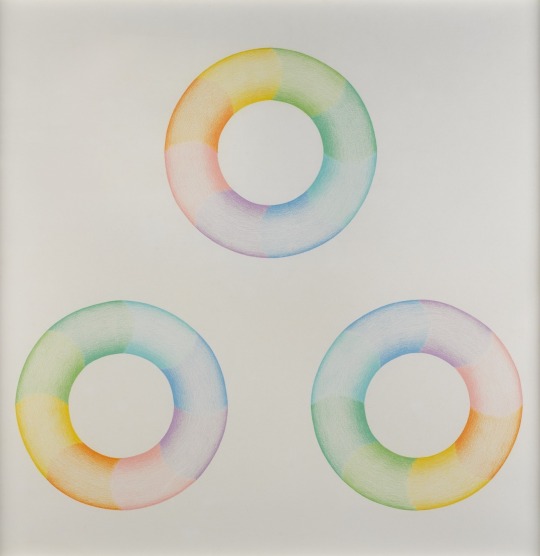
Judy Chicago’s influential career spans six decades, and Brooklyn Museum is the home of her feminist tour-de-force The Dinner Party (1974-79). Chicago’s 1960s paintings, drawings and sculptures, feature color and content that challenged the dominant minimalist style of the time. In her work Untitled Donut Drawing, Chicago’s exacting hand traces what she called “central-core” imagery that would align with her ideas of representing women in abstract art in the following years.
See this Chicago’s drawing in Out of Place: A Feminist Look at the Collection on view alongside The Dinner Party through January 3, 2021.
Posted by Carmen Hermo
Judy Chicago (American, born 1939). Untitled Donut Drawing, 1968. Colored Pencil with graphite under drawing. Brooklyn Museum, Gift of the Paula Hays Harper Trust, 2013.79. © artist or artist's estate
37 notes
·
View notes
Photo
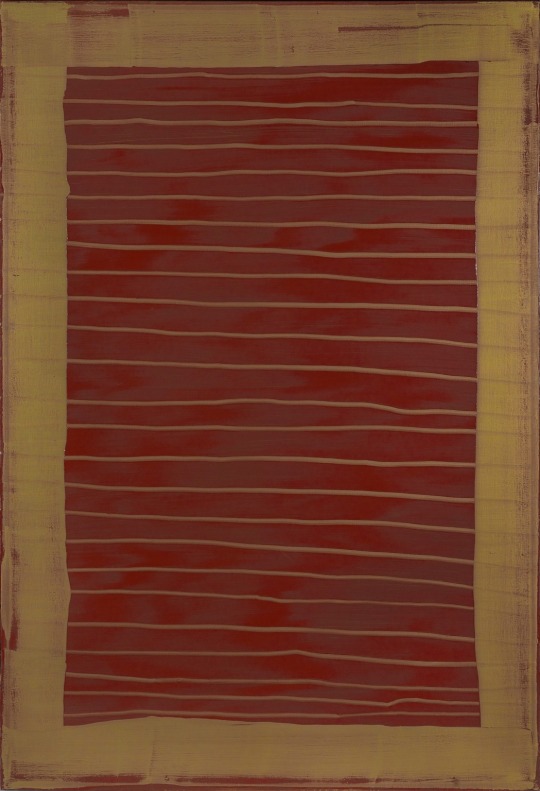
Mary Heilmann is an American contemporary artist whose works include paintings, works on paper, ceramics, and furniture. “Blinds” is an oil painting that showcases Mary Heilmann’s intention to ground artistic abstraction in everyday objects. “Blinds” comes from a series of abstract works inspired by the artist’s immediate surroundings, such as air vents, French doors, and window blinds. Heilmann’s attraction to painting exemplifies her Feminist ideology as Heilmann states that her decision to start painting in 1968 was a calculated and “antagonistic move” against the expectations of art to conform to the opinions of white male critics who labeled the medium “dead”.
See Heilmann's Blinds on view in Out of Place: A Feminist Look at the Collection through January 3, 2021.
Posted by Christian Reeder
Mary Heilmann (American, born 1940). Blinds, 1975. Oil on canvas. Brooklyn Museum, Gift of The Solomon Foundation, 2009.7.3. © artist or artist's estate
#outofplacebkm#mary heilmann#contemporary art#paintings#oil painting#blinds#everyday objects#abstract#feminist art#feminism#brooklyn museum
37 notes
·
View notes
Photo
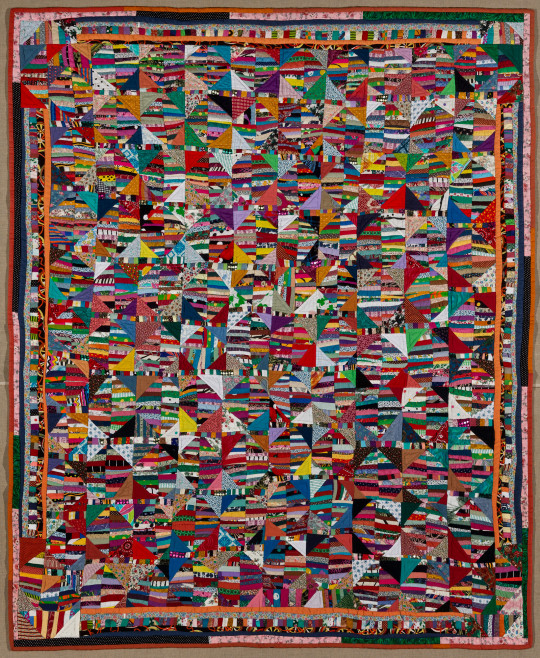
Anna Williams, a self-taught quilter born and raised near Baton Rouge, Louisiana, was seen as one of the twentieth century’s most significant fiber artists. The quilts she made throughout her life incorporated scraps of traditional printed cottons, unusual synthetics, and woven or decorated fabrics such as the sequined pieces seen in this work. Without employing templates or blocking, Williams created bold freehand, improvisational designs that embodies a polyrhythmic African-American aesthetic. The visual complexity of her work, which contradicts the craft’s domestic origins, continues to influence scores of contemporary quilt artists.
Quilt, 1995 was the first quilt by a known African American maker to enter the Brooklyn Museum collection. See it now on view in Out of Place: A Feminist Look at the Collection.
Posted by Jenée-Daria Strand
Anna Williams (American, 1927-2010). Quilt, 1995. Cotton, synthetics. Brooklyn Museum, Gift in memory of Horace H. Solomon, 2011.18
#Anna Williams#black history month#blackhistorymonth#bhm#outofplacebkm#quilt#quilter#fiber artist#scraps#cotton#synthetic#woven#decorated#freehand#improvisational#design#art#artist#domestic#influence#african-american#aesthetic#polyrhythmic
612 notes
·
View notes
Photo
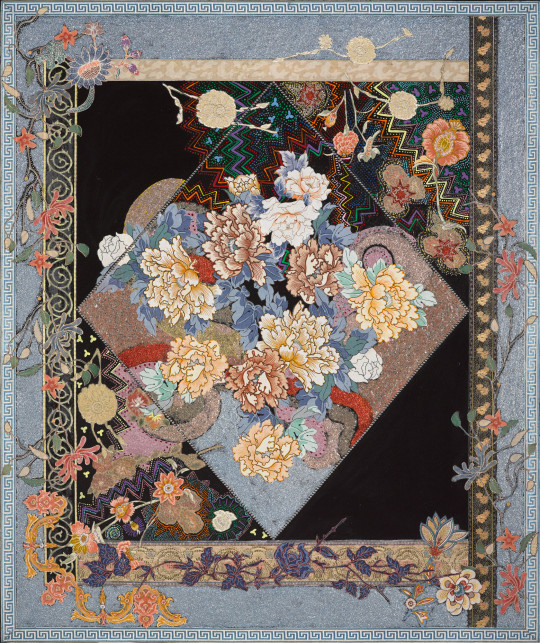
Miriam Schapiro was a painter, sculptor, printmaker and “femmagist” born in 1923 to Jewish parents of Russian descent. A trailblazing feminist artist, Miriam Schapiro is known for establishing the Feminist Art Program at the California Institute of the Arts with Judy Chicago in 1971. Schapiro put forward the idea that femmage—decorative and domestic elements traditionally considered “women’s work,” were often excluded from museums and the realm of “fine art.”
The visually dense and diverse “Tapestry of Paradise” shows the application of femmage—accumulative and writ large against art history’s diminished view of women artists’ achievements. See it now on view, in Out of Place: A Feminist Look at the Collection.
Posted by Jenée-Daria Strand
Miriam Schapiro (American, 1923-2015). Tapestry of Paradise, 1980. Acrylic and collage on canvas. Brooklyn Museum, Gift of Robert Sugar, 2017.16
#womenshistorymonth#outofplacebkm#miriam schapiro#sculptor#painter#printmaker#femmagist#feminist#art#artist#women's work#museums#art history#women artists#5womenartists
340 notes
·
View notes
Photo



We're sure you're ready to send 2020 packing, but in the meantime, we hope you make the Brooklyn Museum part of your holiday celebrations. There is a lot of art to see, but be sure to visit during the final days of Out of Place: A Feminist Look at the Collection, which closes January 3, and before our special exhibitions featuring contemporary artists Jeffrey Gibson and Kameelah Janan Rasheed close on January 10.
Installation views: Out of Place: A Feminist Look at the Collection, Brooklyn Museum, January 24, 2020 - January 3, 2021 ⇨ Jeffrey Gibson: When Fire Is Applied to a Stone It Cracks, Brooklyn Museum, February 14, 2020 - January 10, 2021 #JeffreyGibsonBKM ⇨ Kameelah Janan Rasheed: Are We Reading Closely? Brooklyn Museum, November 11, 2020–January 10, 2021. (Photos: Jonathan Dorado)
#JeffreyGibsonBKM#OutofPlaceBKM#KameelahJananRasheed#Jeffrey Gibson#Kameelah Janan Rasheed#exhibitions#nyc#holidays#brooklyn#things to do
17 notes
·
View notes
Photo
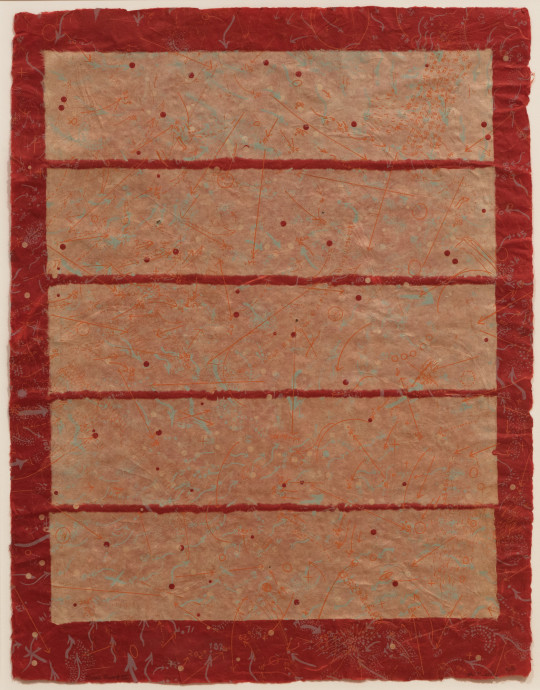
Inspired by the Black Power movement and active as a feminist in the New York art world in the 1970s and ‘80s, Howardena Pindell favored a craft-inspired aesthetic. Her choice of materials aligned with her commitment to political activism. Reflecting her conceptual and material interest in print- and paper-making, Kyoto: Positive/Negative incorporates personal references into abstract forms. The use of rice paper here alludes to the artist’s first trip to Japan in 1979, accompanied by her father, a mathematician. The red dots may allude to a memory of a childhood road trip, when at a root beer stand in northern Kentucky, she and her father were given mugs with red circles on the bottom—a means of designating separate utensils for African Americans under Jim Crow laws.
Posted by Jenée-Daria Strand
Howardena Pindell (American, born 1943). Kyoto: Positive/Negative, June 1980. Lithograph, etching, aquatint, and collage with chine colle on paper.B. Brooklyn Museum, Purchased with funds given by the Louis Comfort Tiffany Foundation, 85.48. © artist or artist's estate
#outofplacebkm#howardena pindell#womenshistorymonth#black power#new york#art#art history#artist#women artists#women's history month#brooklyn museum#political#activism#conceptual#print#paper#kyotostreet#abstract#japan#dots#childhood#road trip#african americans#jim crow
140 notes
·
View notes
Photo
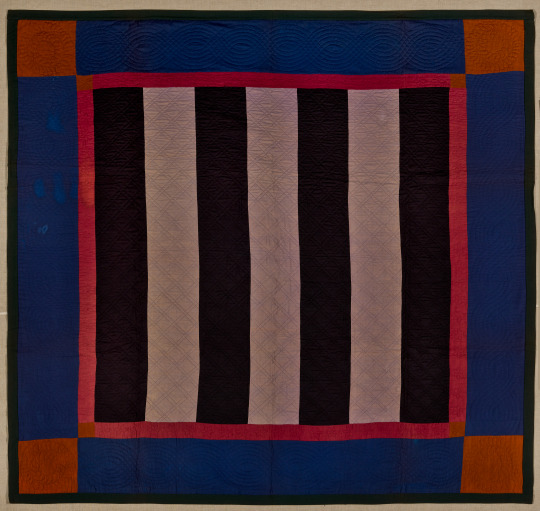
Mini Art Lesson
Tuesday, May 19, 2020
This lesson explores the patterns and shapes that make Amish quilts works of art. Children ages 2–6 can use tape and coloring supplies to recreate the Bars Quilt in the Brooklyn Museum collection. Kids 7+ can learn about designing quilts, using a grid pattern they make themselves and mimicking the stitched patterns that make these quilts so special.
FOR AGES 2–6:
LET’S PLAY
Fun Fact: Amish quilt makers, discouraged from using patterned fabrics, create their own patterns through color blocking and stitching. In that tradition, let’s create our own patterns!
Step 1: Take a look at the shapes and colors used in this quilt. Then, discuss what a pattern is and identify the patterns depicted in the quilt.
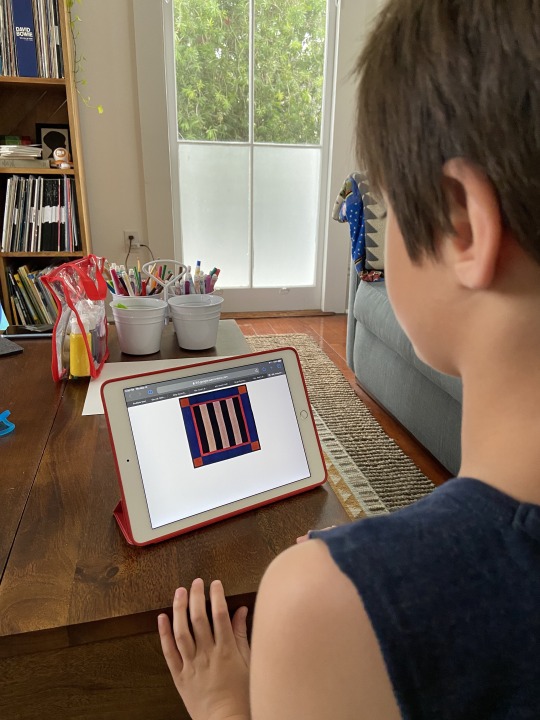
Step 2: Using tape, gently recreate the outline of the quilt’s pattern on a piece of paper.
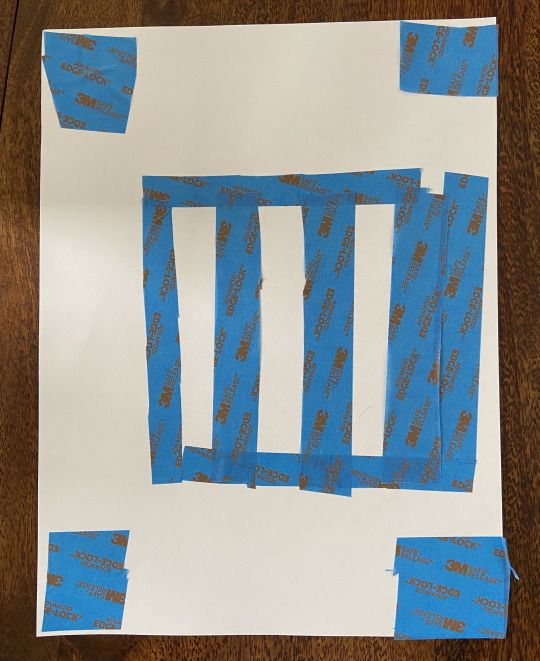
Step 3: With the tape still on the paper, color in or paint the sections of paper that aren’t covered. It is okay if some color gets on the tape!
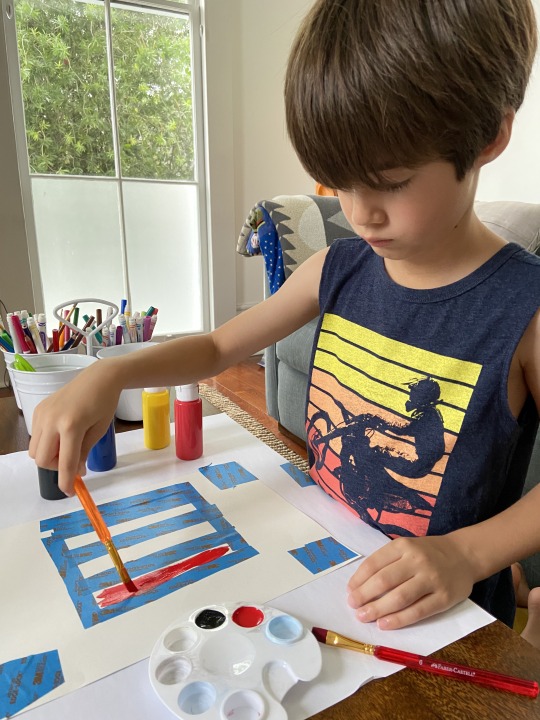
Step 4: Carefully remove the tape from your paper to reveal your pattern!
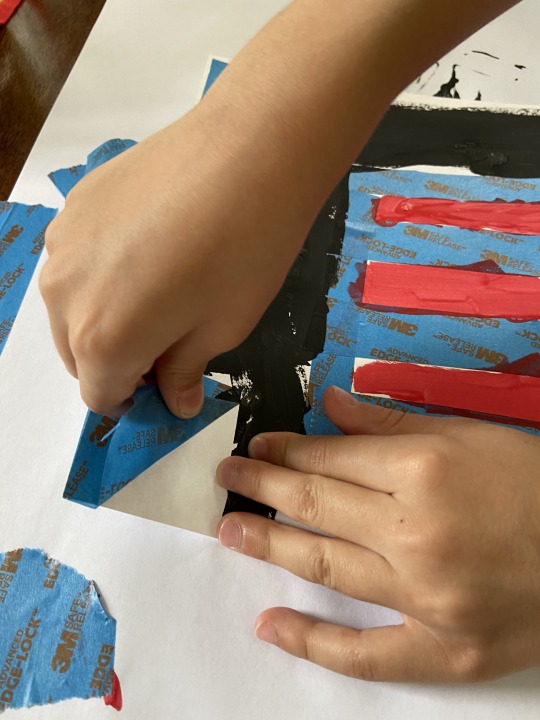
Step 5: Color in the blank spots with another color to finish your quilt. Review the pattern, colors, and shapes with your little one!
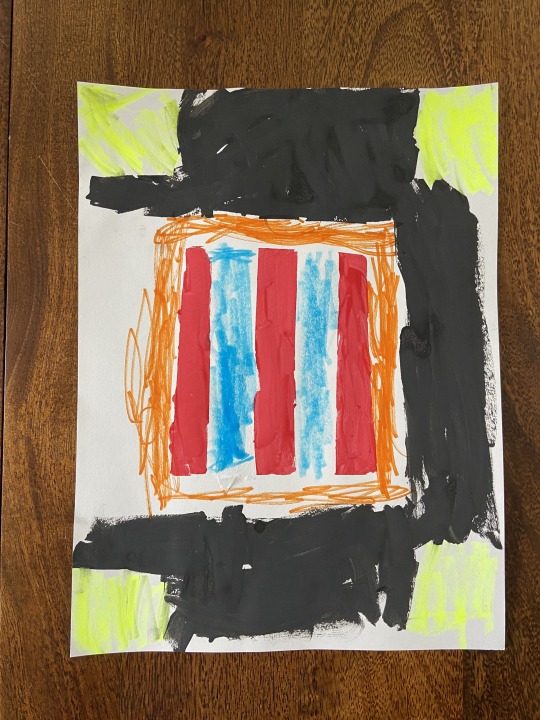
Thank you Anjali and Elliott for your help on this project!
FOR AGES 7+:
LET’S CREATE
Taking inspiration from the bold colors and geometry of the Bars Quilt, let’s create our own quilt designs.
Step 1: Draw out a grid on a sheet of paper with one-inch squares. Tip: You can make the squares bigger for an easier project, or smaller to make it more challenging.
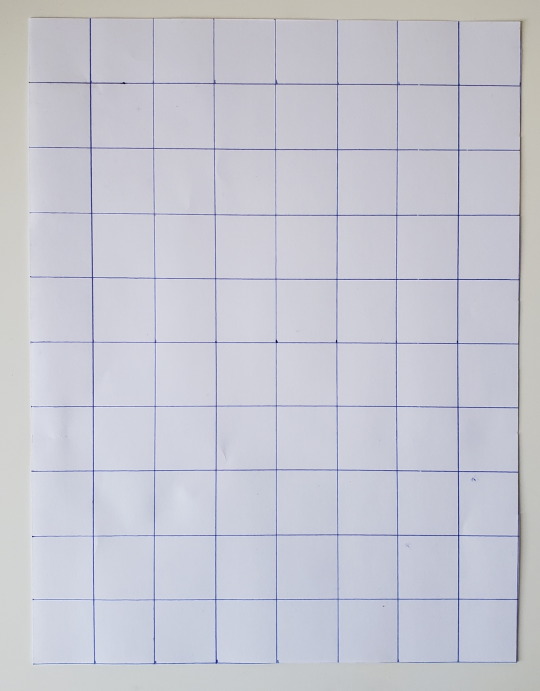
Step 2: Starting in the center, fill in each square with different colored shapes. You can try triangles, squares, rectangles, or stars.

You can make your pattern symmetrical...
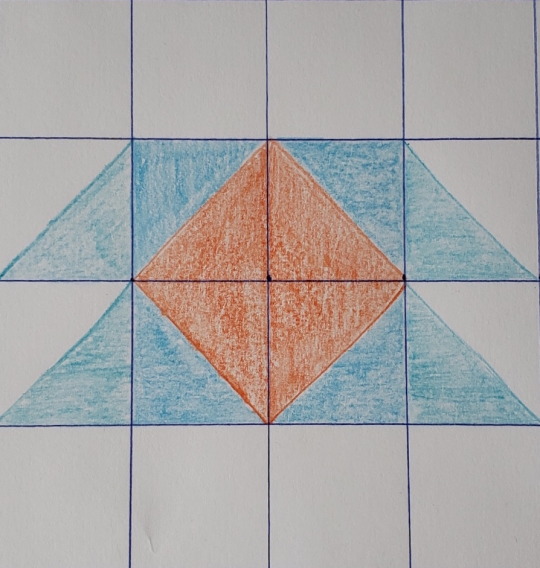
...or asymmetrical.
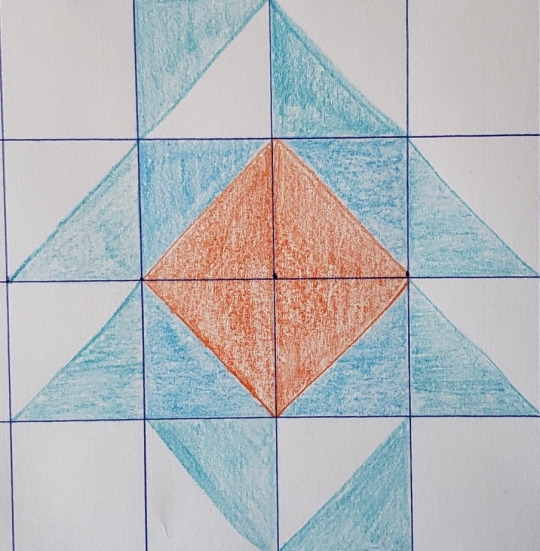
You can fill in large sections with a single color. Or break down each square into subsections.

Step 3: Keep going until you’ve filled in the whole page!

At first glance, the Bars Quilt may seem like it is simply solid blocks of color. But a closer look exposes the eloquent stitching!
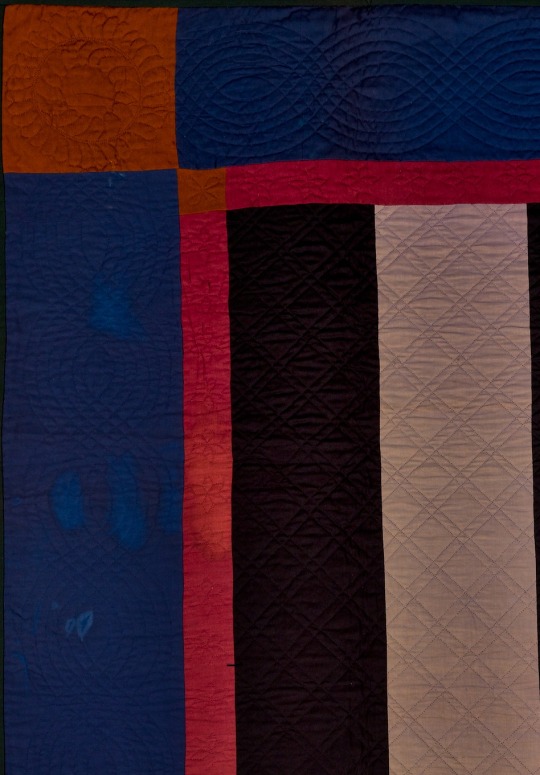
Step 4: Using a pen or marker, create dotted lines on your drawing. These lines will mimic the stitching, creating your own pattern.
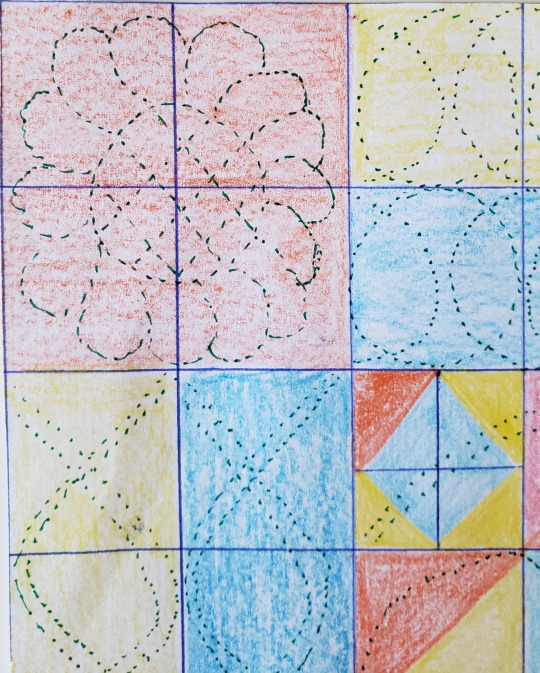
Step 5: Dot your entire page, until your whole quilt design looks stitched.
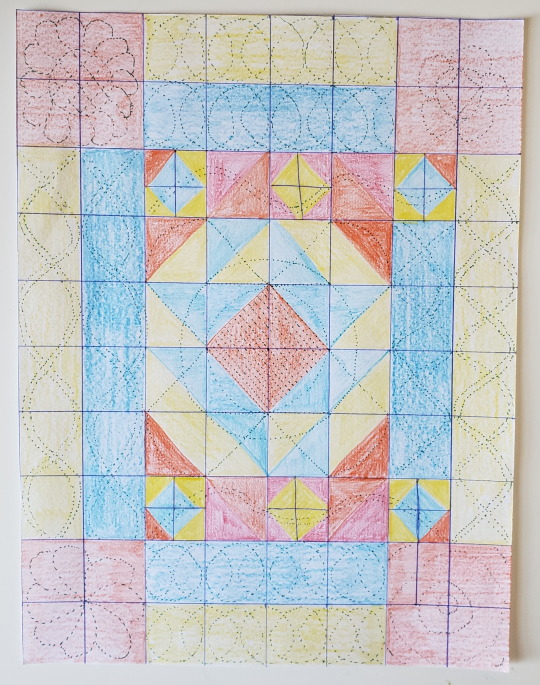
Ask yourself: Does your artwork look different close up than it does far away? How does adding different colors change the overall composition?
Although quilts were originally created to keep us warm, their beautiful designs have earned them a place on museum walls. Where will you hang your design?
FOR TEACHERS, CAREGIVERS, AND PARENTS
Access a free teaching guide, featuring questions for viewing and other great activities and resources
We’ll be back next Tuesday with another Mini Art Lesson! In the meantime, let us know what your like to see or learn!
Posted by Tamar MacKay and Noé Gayt��n
Unidentified artist (American). Bars Quilt, circa 1890. Cotton, wool. Brooklyn Museum; Gift of Mr. and Mrs. H. Peter Findlay, 77.122.3
#miniartlesson#brooklyn museum#museums#bkmeducation#teacher resources#art making#museum from home#education#quilt#outofplacebkm#art lesson#art education#art#miniartlessons
73 notes
·
View notes
Photo
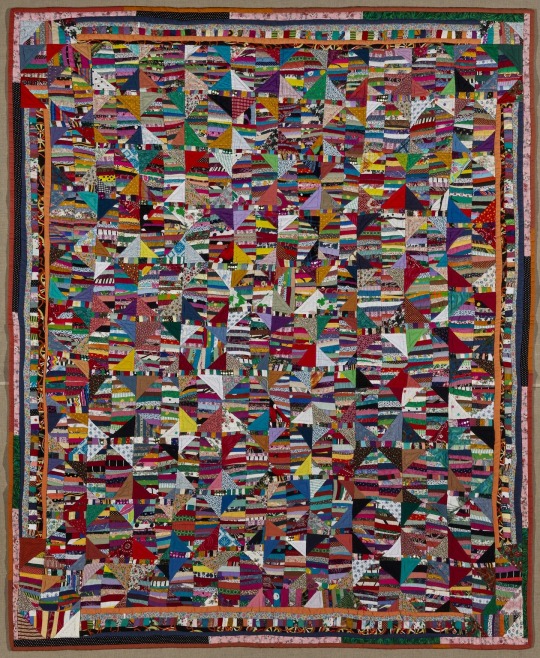
"One of the best parts of working at an art museum is the ability to quietly sneak away from your desk during lunch break to pop into the galleries. During this time of distancing, I am especially missing my gentle moments with Anna Williams' Quilt, currently on view in Out of Place: A Feminist Look at the Collection. Williams' meticulous craftsmanship and eye for fusing textures, colors, and forms reshapes the canon of feminist art to include the art of women working at home, and particularly elevates the work of women of color. It is easy to be drawn to this work for its unapologetic and joyous use of colors, geometric shapes, and alternating patterns. I'm remembering this necessary joy during these weeks when the Museum is closed, and forward to seeing it once the galleries open again."
Posted by June Lei, Public Programs Assistant
Anna Williams (American, 1927-2010). Quilt, 1995. Cotton, synthetics. Brooklyn Museum, Gift in memory of Horace H. Solomon, 2011.18 (Photo: Brooklyn Museum)
#artforthesociallydistanced#brooklyn museum#museums#outofplacebkm#social distancing#coronavirus#Anna Williams#quilt
94 notes
·
View notes
Photo
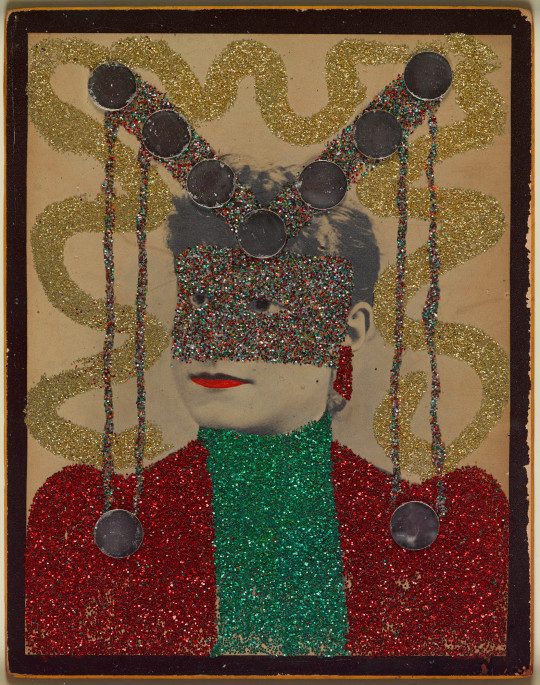
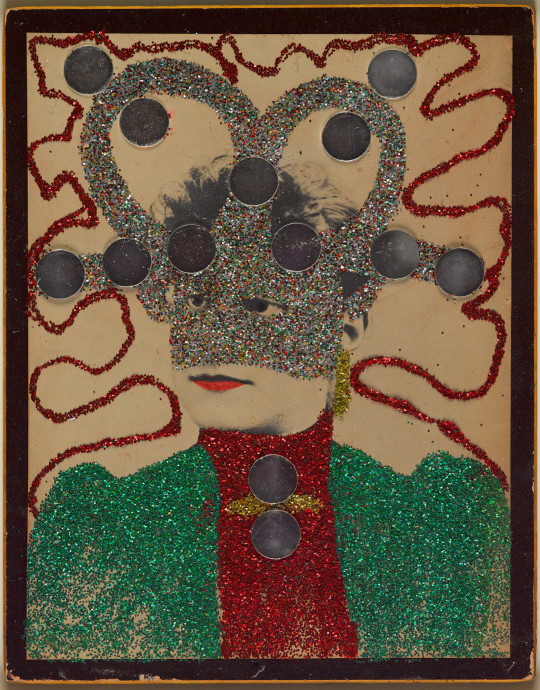
With the pursuit and determination to become an artist, May Wilson left rural Maryland and a decades-long marriage for New York City, at the age of 61 where—as advised by her pen pal, mail artist Ray Johnson, she took up residence at the Chelsea Hotel. Largely self-taught and generations older than the avant-garde artists she was drawn to, Wilson acquired the nickname “Grandma Moses of the Underground”.
Long before the term ‘feminist’ was commonly used, Wilson’s works commented on the sexism and ageism that existed in both popular and “fine-art” portrayals of women. Although May Wilson spoke about her works in formalist rather than political terms, her work accompanied the shifting cultural landscape as a result of the Women’s Liberation movement. In Wilson’s Ridiculous Portraits series, she gathers found objects that share relation to her early life, such as a nineteenth-century portrait of a woman, and embellishes them with glitter, small mirrors and red paint. Produced as personal mementos and often exchanged through the mail with other artists as gifts, Wilson’s portraits attacked sexism, ageism, and the cult of beauty with a wry sense of absurdity.
See a pair of these Ridiculous Portraits, now in Out of Place: A Feminist Look at the Collection.
Posted by Jenée-Daria Strand
May Wilson (American, 1905-1986). Untitled I (Portrait) ⇨ and Untitled II (Portrait), 1966-1967. Albumen photographs with glitter and mirrors and red paint. Brooklyn Museum, Emily Winthrop Miles Fund, 2007.11.1 and 2007.11.2.
#womenshistorymonth#outofplacebkm#may wilson#grandma moses of the underground#new york city#feminist art#bkmfeministart#feminists#5womenartists#chelsea hotel#art#artists#women artists#sexism#ageism#fine-art#formalist#women's liberation movement#ridiculous portraits#portraits#found objects#embellish#glitter#mirrors#paint#mixed media
109 notes
·
View notes
Photo
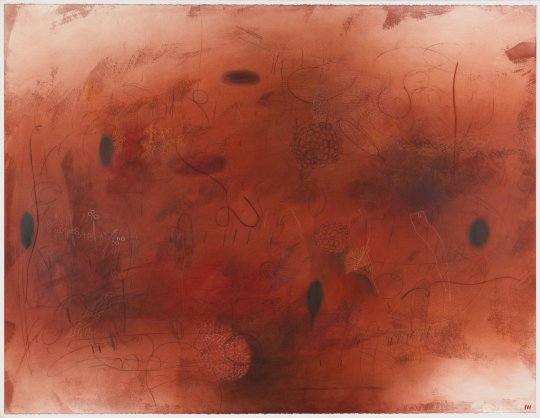
"I pause every time I walk by this work on the 4th floor. There's so many parts of it that resonate with me: the abstracted landscape, the references to weaving and dyeing, the colors and how they evoke the Southwest—a region of the country that I am intimately familiar with. Emmi Whitehorse is one of my favorite artists, and I felt overwhelmed with emotion when I learned that this work was on display in Out of Place: A Feminist Look at the Collection. It's so expressive and exciting to me, and I could sit with it for hours just finding more and more details, symbols, layers. This is the second time I've seen Whitehorse's work on display at a major museum within the past year, so it brings me joy to see her becoming more widely recognized."
Posted by Kat Chavez, School, Teen, and Family Programs Fellow, Education
Emmi Whitehorse (Navajo, born 1957). Fire Weed, 1998. Chalk, graphite, pastel and oil on paper mounted on canvas. Brooklyn Museum, Gift of Hinrich Peiper and Dorothee Peiper-Riegraf in honor of Emmi Whitehorse, 2006.49. © artist or artist's estate (Photo: Brooklyn Museum)
#artforthesociallydistanced#brooklyn museum#museums#coronavirus#social distancing#emmi whitehorse#outofplacebkm
89 notes
·
View notes
Photo
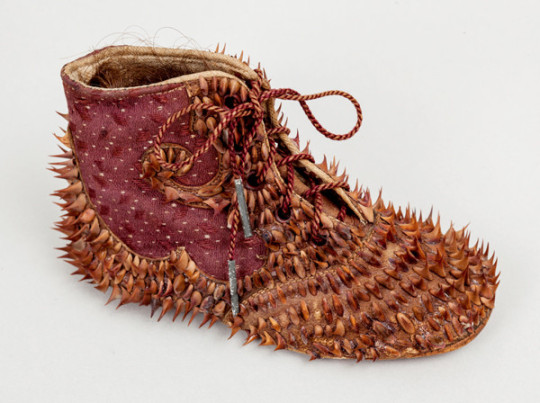
Nancy Youdelman was a costume design student at Fresno State University in 1970 when she joined Judy Chicago’s groundbreaking Feminist Art Program. Since then, Youdelman has fused her background in textiles and costumes with pointed feminist critique. In Thorn Shoe (1976), a child’s shoe stuffed with hair and adorned in prickly thorns alludes to the potential pain and suffocating sacrifice of motherhood under patriarchy. Youdelman was part of a wave of feminist artists in the early 70s who advocated for women to make art based on their own real-life experiences.
Posted by Carmen Hermo
Nancy Youdelman (born New York, New York 1948). Thorn Shoe, 1976. Rose thorns, fabric, leather, metal hardware, human hair. Brooklyn Museum, Gift of Gail Levin and John B. Van Sickle, 2018.35.
#womenshistorymonth#outofplacebkm#nancy youdelman#costume#judy chicago#feminist art program#textile#costume designer#art#artist#feminist art#feminist#shoeplay#hair#throns#pain#motherhood#patriarchy#70s#feminist artists#women#art history#women's history month#5womenartists
94 notes
·
View notes